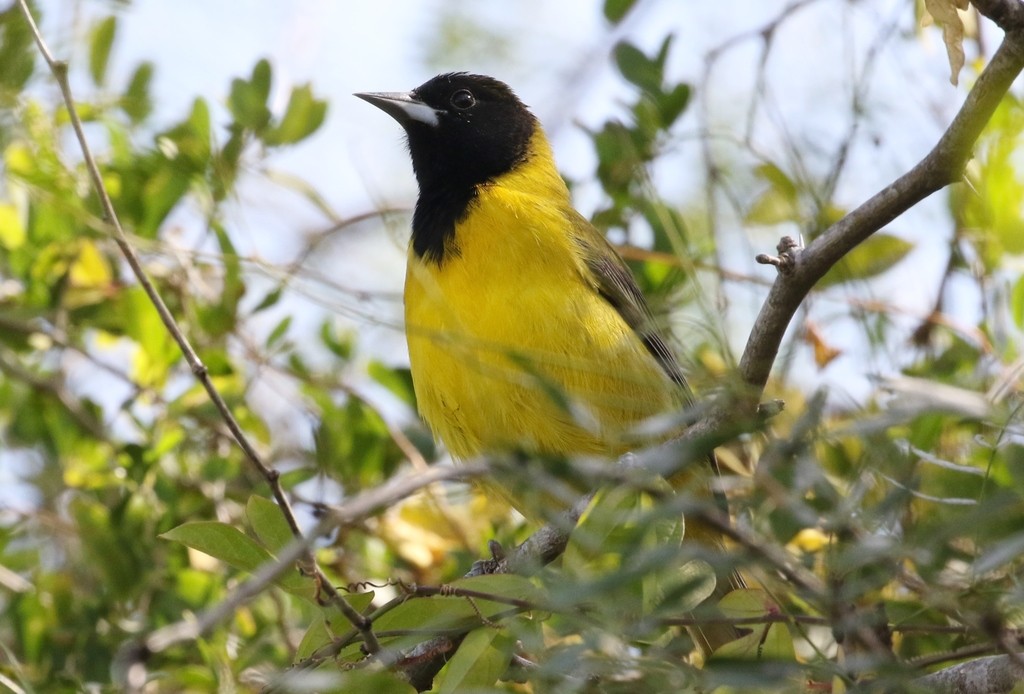Audubon's Oriole
A species of New world orioles Scientific name : Icterus graduacauda Genus : New world orioles
Audubon's Oriole, A species of New world orioles
Botanical name: Icterus graduacauda
Genus: New world orioles
Content
Description General Info
 Photo By silversea_starsong , used under CC-BY-NC-4.0 /Cropped and compressed from original
Photo By silversea_starsong , used under CC-BY-NC-4.0 /Cropped and compressed from original Description
The male of the species has a black hood, mandible, and throat, as well as a black tail. Wings are black, but the remiges and rectrices (flight feathers) are fringed with white. The secondary coverts form yellow epaulets. The back and vent are yellow washed with olive, and the underside is almost uniformly yellow. Females of this species have a slightly more olive nape and back than the males. The adult female's plumage is similar to the juvenile plumage; however, unlike adults, the wings are dull brown instead of black. In general, immature specimens have the hood; wingbars; remiges; and epaulets of adult specimens. The first-basic plumage retains the darker, greener coloration of the juvenile plumage, however. Molting generally occurs in early autumn, though some specimens have been noted to molt as early as June. 
Size
22-24 cm (8.5-9.5 in)
Colors
Black
Yellow
Gold
White
Life Expectancy
12 years
Nest Placement
Tree
Clutch Size
3 - 5 eggs
Feeding Habits
Audubon's Oriole forage for insects, spiders, and fruit by gleaning from foliage or the ground. Their diet includes beetles, butterflies, caterpillars, and arachnids, complemented by mesquite beans, cactus fruit, hackberries, plus orchard fruits like peaches, apples, and plums. They apply 'gaping' to access larvae and occasionally consume nectar or sunflower seeds from feeders.
Habitat
Audubon's Oriole's habitat spans dense woodlands, brushy areas, and stream corridors with lush vegetation like willows or phragmites. They favor a variety of environments from mesquite bosques to wooded streams, oak stands, and vegetated urban areas. Their altitude range varies from lowlands to cloud forests, including pine-oak, deciduous forests, arid thorn forest, and scrubs, and they thrive in forest edges with dense cover.
Nest Behavior
Audubon's Oriole females likely choose the tree branch for their nest, which is built during the breeding season. Parental care involves meticulous weaving of nesting materials and incubation of laid eggs.
Nest Characteristics
The nest of audubon's Oriole is a shallow hanging cup, typically situated in the outer branches of a tree, 5–15 feet above ground. Constructed by females, it's woven from grasses and plant fibers, notably palmetto, and lined with grass, plant fiber, and hair. The nest measures approximately 3.7 inches in both diameter and height, with an interior cup around 3.0 inches wide and 2.8 inches deep.
Dite type
Insectivorous
General Info
Feeding Habits
Bird food type
Bird Feeder Type

Platform
Sounds
Song
Recording location: Mexico
Song
Recording location: Mexico
Behavior
Audubon's Oriole display a unique synchronization between males and females, starting their melodious duets with the onset of spring rains, which invigorates their insect prey and lush habitat. They keep in close proximity, especially during nest construction, relying heavily on vocal communication. Interestingly, their territorial defense is more subdued compared to other species, with outright confrontations being rare. Nest-building is a female's endeavor, but both partners share in the incubation and chick-rearing duties, maintaining the family bond well after the offspring fledge. Demonstrating monogamous traits, audubon's Oriole pairs persist together throughout the year, often joining communal foraging groups comprised of various bird species during off-breeding periods.
Species Status
Not globally threatened.